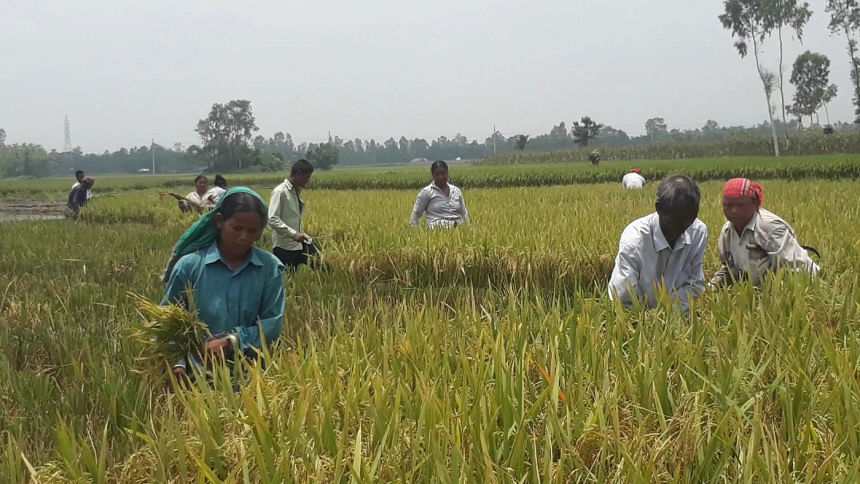Highest production of Aus in 20yrs

This season farmers in the district have recorded the highest production of Aush paddy in the last 20 years due to favourable weather.
According to Department of Agricultural Extension (DAE) officials in Thakurgaon, farmers have produced 81,962 tonnes of rice by cultivating 24,090 hectares of land this year.
Experts said transplantation of paddy saplings after 15 March is considered as Aush and before that it is under Boro season. Usually, the farmers start cultivating Aush paddy after harvesting Rabi crops from mid-March and the season ends in mid-August.
Farmers are now preferring to cultivate paddy in Aush season instead of Boro season as they do not need to spend extra money for its cultivation. During the Aush cultivation period, they do not require any irrigation due to heavy rains.
Besides, farmers, who wait for Aman cultivation after harvesting Rabi crops including potato and maize, can get additional Aush crops in between Rabi and Aman season.
Many are switching to Aush from Boro cultivation due to its lower production cost. As a result, the cultivation area is increasing every year.
The DAE officials said Aush cultivation is increasing in each season as the government has taken different initiatives including supply of agricultural inputs to farmers' level with an aim to increase Aush cultivation using rainwater that helps to reduce the dependency on groundwater.
Aftab Ahmed, deputy director (DD) of Department of Agriculture Extension (DAE) in Thakurgaon, said a total of 4,500 growers in the district have been provided agricultural inputs.
Each of them has been provided 5kg seeds of high yielding paddy, 20kg of diammonium phosphate (DAP) and 10kg Muriate of Potash (MOP) for free of cost to cultivate Aush paddy on one bigha of land.
The government provided agricultural inputs to encourage farmers for Aush cultivation using rainwater to reduce the dependency on groundwater to save the ecology, he added.
Farmers of the Rangpur region have started cultivating Aush in the 2000-01 fiscal year, he added.
The Aush cultivation area is increasing every year, said the DD.
In the 2015-16 fiscal year, about 10,102 hectares of land have been brought under Aush cultivation, about 11,997 hectares in 2016-17, about 14,820 hectares in 2017-18, about 20,385 hectares in 2018-19, about 20,590 hectares in 2019-20 and 24,090 hectares in the current season.
The farmers cultivated hybrid variety on 7,695 hectares of land in the district while high-yielding variety was cultivated on 16,395 hectares of land.
The high-yielding varieties like BRRI Dhan28, BRRI Dhan48, BRRI Dhan83, BINA Dhan19, Nerica and Nerica mutant were cultivated in Thakurgaon.
Shafiqul Islam, 42, of Chameswary village in Thakuraon Sadar upazila said he cultivated on two bighas of land spending Tk14,000 and got 38 maunds of paddy.
Fazir Uddin, 45, of Bachor village in Ranishankoil upazila of the district said he cultivated BRRI Dhan48 on two bighas of land and got 40 maunds of paddy spending only Tk15,000. The Aush cultivation costs were almost half than the cost of cultivating paddy in Boro season.
"The incentives provided by the government have encouraged us to cultivate paddy in Aush season," he added.
DD Aftab Ahmed said vast tracts of lands in the areas that good for Aush cultivation have remained uncultivated after harvesting Rabi crops.
The government has provided special incentives and technical support to the farmers to turn the land into three-crop land through Aush cultivation, said Aftab.

 For all latest news, follow The Daily Star's Google News channel.
For all latest news, follow The Daily Star's Google News channel. 



Comments